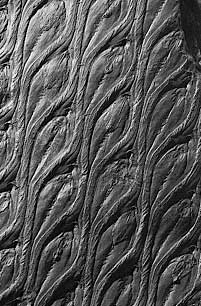|
|
|
PALEONTOLOGY ARTICLE
Lepidodendron
by MIKE BALDWIN

|
06.21.00--The most common lycopod fossil is probably the
Lepidodendron. The rounded, diamond-shaped structures
arranged in rows (in the photograph to the left) are
leaf cushions and scars. Lepidodendron bore its leaves
directly on the trunk in spiral rows. The roots, leaves,
and cones of this tree are also known as independent
fossils, and each structure has a different name. The
roots are called Stigmaria; the leaves are called
Lepidophyllum; and the cones are called Lepidostrobus.
Lycophytes, or lycopods include the most primitive
trees. They were dominant in the coal swamps of the
Mississippian and Pennsylvanian Periods of the Devonian
Age. Much of the coal mined in North America today comes
from the leaves, trunks, and stems of these plants, some
of which grew to heights of more than 100 feet. There
are only three genera of living lycopods. They are
called club mosses and are very small.
|
Lycopods produced much as ferns do. Spores were borne in
cones. When the cone opened, the spores fell into water (the
lycopods of the Paleozoic probably all lived in swamps), where
they sprouted and grew into tiny plants.
The information above was derived from the National Audobon
Society Field Guide to North American Fossils by Ida Thompson,
1996.
|
|
|

